Nonpathogenic Lactose Fermenters (name 3)
|
|
E. coli, Enterobacter. Klebsiella
|
| |
Nonpathogenic Lactose Non-fermenters (name 1)
|
|
Proteus |
| |
Pathogenic Lactose Non-fermenters (name 2)
|
|
Salmonella, Shigella
|
| |
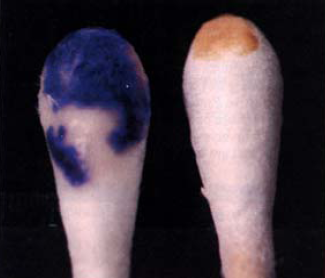
Oxidase test. Direct method used on Pseudomonas aeruginosa and Escherichia coli. Which is the positive result and which is the negative?
|
|
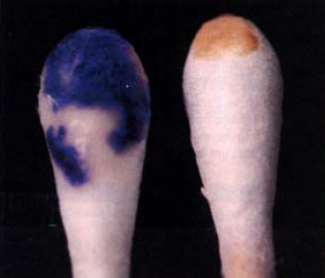
Pseudomonas: Positive with a purple/blue color change.
Escherichia: Negative with no color change.
|
| |
Pseudomonads are obligate aerobes and use an electron transport (or oxidation-phosphorylation) system that includes an enzyme called....
|
|
Cytochrome c oxidase
(Cytochrome c oxidase picks up electrons and passes them to a pigment called cytochrome c, which is part of the electron transport pigment system needed for aerobic respiration. This oxidase reagent acts as a false electron donor so if Cytochrome c oxidase is present, it will take the electrons from the oxidase reagent. When the reagent becomes oxidized, by giving away the electrons, it turns purple.)
|
| |
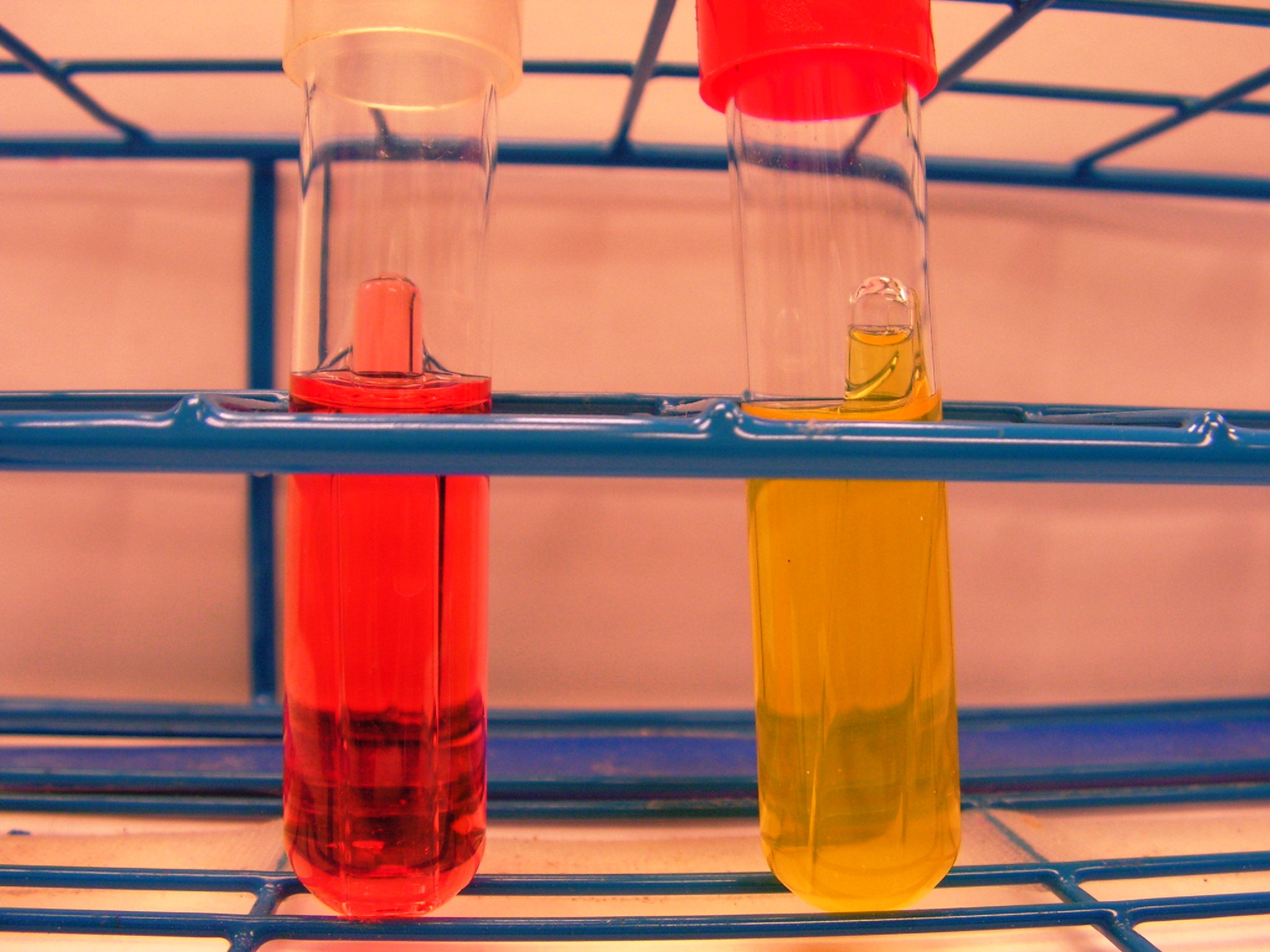
Lactose fermentation tests using Phenol red lactose broth (PR lactose broth) used on Escherichia coli and Salmonella typhimurium.
|
|
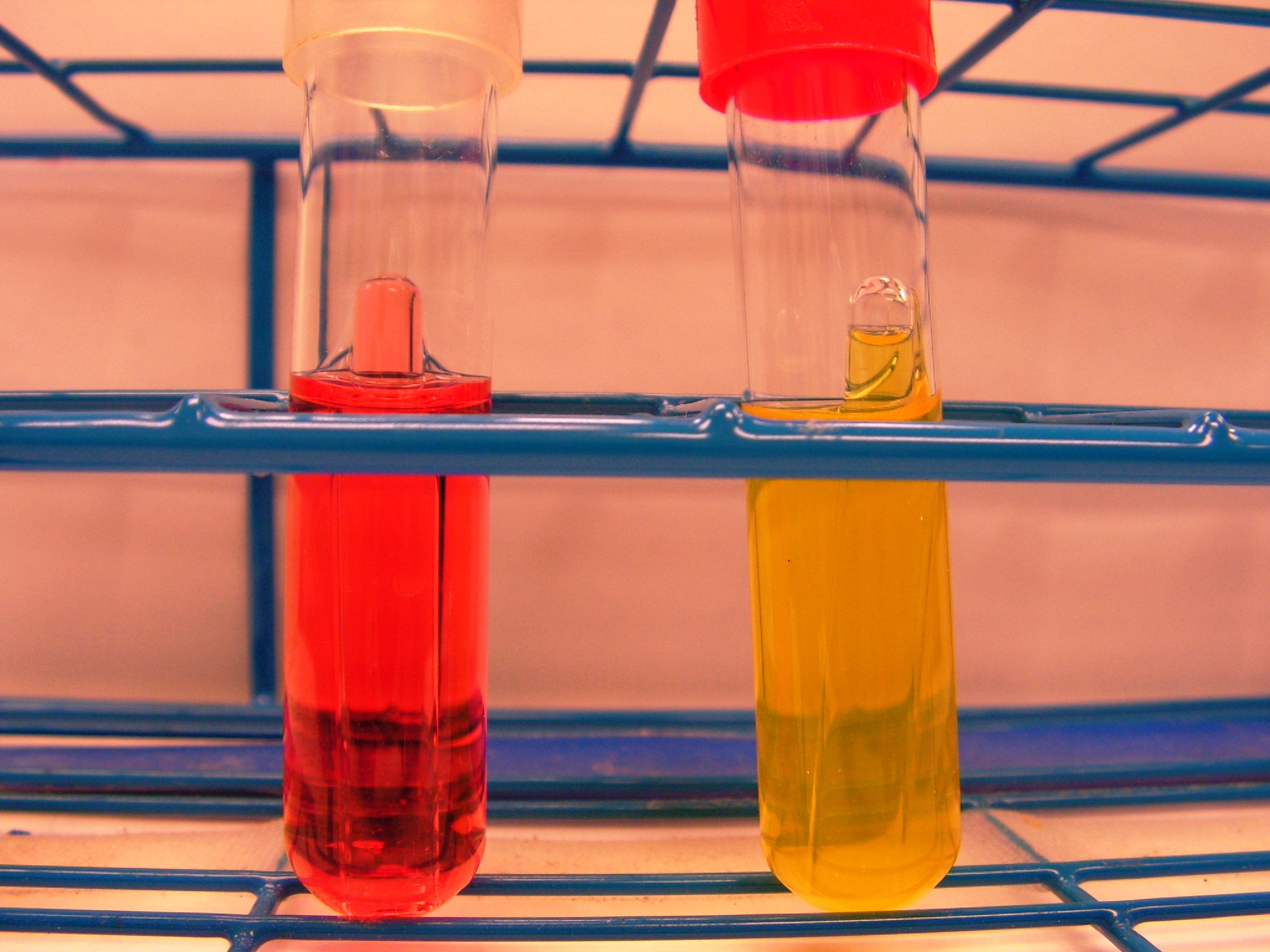
Escherichia coli: Positive with yellow (acidic) coloration; Positive for gas production.
Salmonella typhimurium: Negative with orange/red (neutral) coloration; Negative for gas production.
|
| |
Phenol red shifts (pH and coloration)
|
|
Alkaline pH -------> cerise pink
Neutral pH --------> red (when lactose is present)
Acidic pH ----------> yellow (positive)
Remember: Most enterics are Lactose fermenters (LF) while potential pathogens will be Lactose nonfermenters (LNF).
|
| |
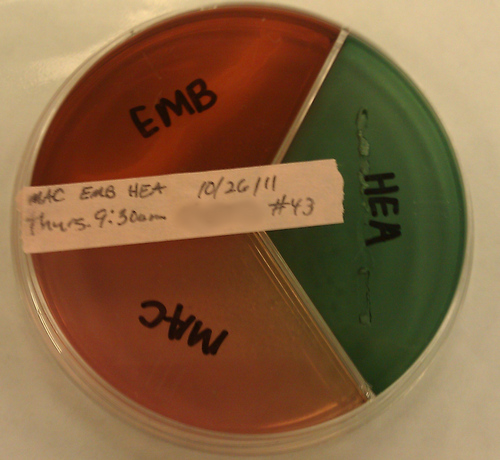
Lactose fermentation and bile salt tolerance using MacConkey's Agar (MAC), Eosin Methylene Blue Agar (EMB), and Hektoen Enteric Agar (HEA).
On MAC, anything that grows is.....
|
|
Bile salt/dye tolerant
|
| |
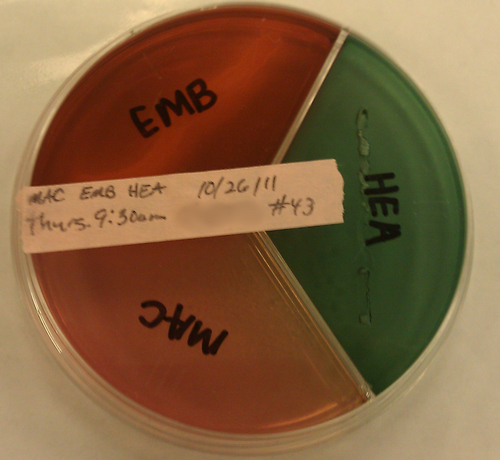
Lactose fermentation and bile salt tolerance using MacConkey's Agar (MAC), Eosin Methylene Blue Agar (EMB), and Hektoen Enteric Agar (HEA).
On MAC, any growth that is pink or pinkish is a ......
|
|
Lactose Fermenter (LF)
|
| |
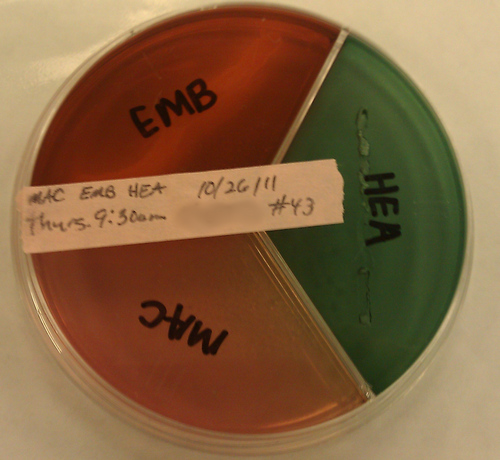
Lactose fermentation and bile salt tolerance using MacConkey's Agar
(MAC), Eosin Methylene Blue Agar (EMB), and Hektoen Enteric Agar (HEA).
On MAC, any growth that is clear or colorless is a ......
|
|
Lactose nonfermenter (LNF).
|
| |
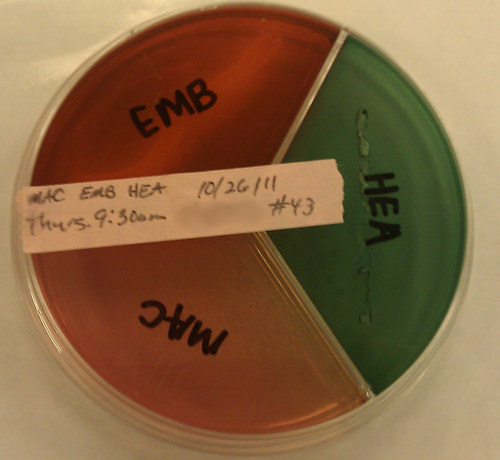
Lactose fermentation and bile salt tolerance using MacConkey's Agar
(MAC), Eosin Methylene Blue Agar (EMB), and Hektoen Enteric Agar (HEA).
On EMB, anything that grows is.....
|
|
Dye tolerant
|
| |
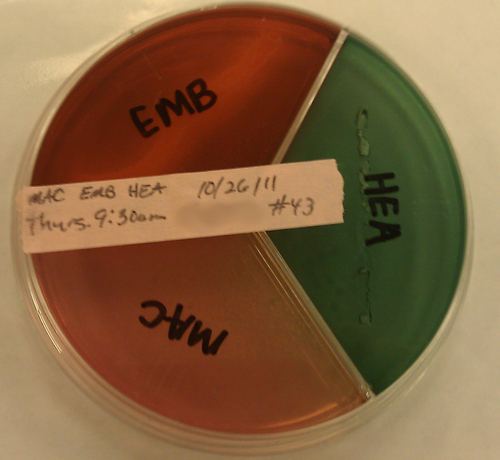
Lactose fermentation and bile salt tolerance using MacConkey's Agar
(MAC), Eosin Methylene Blue Agar (EMB), and Hektoen Enteric Agar (HEA).
On EMB, any growth that is dark purple or purplish is a .......
|
|
Lactose fermenter
|
| |
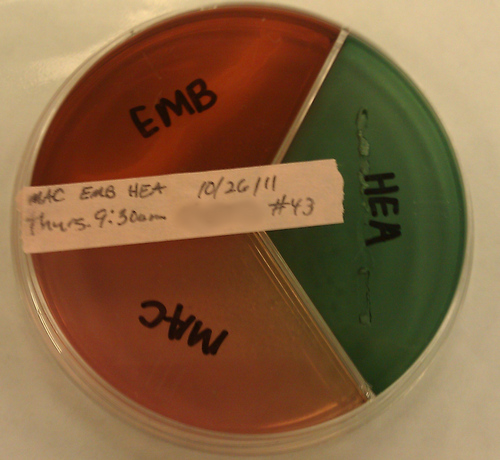
Lactose fermentation and bile salt tolerance using MacConkey's Agar
(MAC), Eosin Methylene Blue Agar (EMB), and Hektoen Enteric Agar (HEA).
On EMB, any growth that is transparent is a ........
|
|
Lactose nonfermenter
|
| |
Lactose fermentation and bile salt tolerance using MacConkey's Agar
(MAC), Eosin Methylene Blue Agar (EMB), and Hektoen Enteric Agar (HEA).
On HEA, anything that grows is .....
|
|
Bile salt/dye tolerant
|
| |
Lactose fermentation and bile salt tolerance using MacConkey's Agar
(MAC), Eosin Methylene Blue Agar (EMB), and Hektoen Enteric Agar (HEA).
On HEA, any growth that is bright orange to salmon pink is a ......
|
|
Lactose fermenter
|
| |
Lactose fermentation and bile salt tolerance using MacConkey's Agar
(MAC), Eosin Methylene Blue Agar (EMB), and Hektoen Enteric Agar (HEA).
On HEA, any growth that is green/clear/colorless is a ...... |
|
Lactose nonfermenter
|
| |
Lactose fermentation and bile salt tolerance using MacConkey's Agar
(MAC), Eosin Methylene Blue Agar (EMB), and Hektoen Enteric Agar (HEA).
On HEA, any growth that is green with black precipitation is a ..... and produces ......
|
|
Lactose nonfermenter and produces hydrogen sulfide
(HEA is unique because not only does it select for gram-negative bacteria, contains the inhibiting agent bile salt, and differentiates organisms based on lactose or non lactose fermentation; it also differentiates organisms on the basis of hydrogen sulfide production.)
|
| |
Recorded results for MAC: E. coli, Salmonella, Bacillus cereus.
|
|
E. coli: Positive for Bile salt/dye tolerance; Positive (red) for Lactose fermentation
Salmonella: Positive for Bile salt/dye tolerance; Negative (tan/clear) for Lactose fermentation
Bacillus cereus: Negative for Bile salt/dye tolerance; Negative for Lactose fermentation
(Explanation: MAC media characteristics: selective and differential. Look for signs of growth vs. no growth from the selective components of the MAC (bile salts and crystal violet). Bile salts and a small amount of crystal violet can inhibit the growth of gram-positive bacteria. Also look at the color of any colonies present due to the differential components of MAC (lactose and neutral red pH indicator). Lactose fermenters will be pinkish due to the uptake and fermentation of lactose and neutral red, while Lactose nonfermenters will be colorless due to the lack of uptake of lactose and neutral red.)
|
| |
Recorded results for EMB: E. coli, Salmonella, Bacillus cereus.
|
|
E. coli: Positive for Bile salt/dye tolerance; Positive (metallic/dark purple colonies) for Lactose fermentation
Salmonella: Positive for Bile salt/dye tolerance; Negative (pink colonies) for Lactose fermentation
Bacillus cereus: Scanty for Bile salt/dye tolerance; Negative (pink colonies) for Lactose fermentation
(Explanation: EMB media characteristics: selective and differential. Look for signs of growth vs. no growth from the selective components of EMB (eosin-y and methylene blue). Eosin-y and methylene blue can inhibit the growth of gram-pisitive bacteria. Also look at the color of any colonies present due to the differential components of EMB (lactose, eosin-y and methylene blue). These inhibiting agents combine to form a precipitate at acid pH thus serving as indicators of acid production. Strong lactose fermenters will be dark purple/black with a metallic sheen due to the update and fermentation of lactose, slow or weak lactose fermenters will be purple, and lactose nonfermenters will be transparent due to the lack of uptake of lactose.)
|
| |
Recorded results for HEA: E. coli, Salmonella, Bacillus cereus
|
|
E. coli: Positive for Bile salt/dye tolerance; Positive (salmon pink/orange) for Lactose fermentation; Negative for H2S
Salmonella: Positive for Bile salt/dye tolerance; Negative (green) for Lactose fermentation; Positive (black) for H2S
Bacillus cereus: Negative for Bile salt/dye tolerance; Negative for Lactose fermentation; Negative for H2S
(Explanation: HEA media characteristics: selective and differential. Look for signs of growth vs. no growth from the selective components of HEA (bile salts). Bile salts can inhibit the growth of gram-positive bacteria. Also look at the color of any colonies present due to the differential components of HEA (lactose, acid fuchsin, bromthymol blue pH indicator, and ferric ammonium citrate). Lactose fermenters will be bright orange to salmon pink due to the uptake and fermentation of lactose. Bromthymol blue and acid fuchsin dyes are added as color indicators. Ferric ammonium citrate is added to react with H2S and forms a black precipitate (dots). Lactose nonfermenters and non-Hydrogen sulfide producers will be green due to the lack of uptake of lactose. Lactose nonfermenters and H2S producers will be green with black precipitate.)
|
| |
